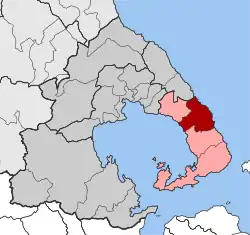Afetes
Αφέτες | |
|---|---|
 Afetes Location within the regional unit  | |
| Coordinates: 39°17′N 23°11′E / 39.283°N 23.183°E | |
| Country | Greece |
| Administrative region | Thessaly |
| Regional unit | Magnesia |
| Municipality | South Pelion |
| • Municipal unit | 80.7 km2 (31.2 sq mi) |
| Highest elevation | 800 m (2,600 ft) |
| Lowest elevation | 0 m (0 ft) |
| Population (2011)[1] | |
| • Rural | 341 |
| • Municipal unit | 1,746 |
| • Municipal unit density | 22/km2 (56/sq mi) |
| Time zone | UTC+2 (EET) |
| • Summer (DST) | UTC+3 (EEST) |
| Postal code | 370 10 |
| Area code(s) | 24230 |
| Vehicle registration | ΒΟ |
Afetes (Greek: Αφέτες) is a village and a former municipality in Magnesia, Thessaly, Greece. Since the 2011 local government reform it is part of the municipality South Pelion, of which it is a municipal unit.[2] The municipal unit has an area of 80.744 km2.[3] Population 1,746 (2011). The seat of the municipality was in Neochori. Afetes is situated in the Pelion peninsula, 2 km from the Pagasetic Gulf coast, 4 km southwest of Neochori, 6 km northwest of Argalasti and 23 km southeast of Volos.
The name Afetes was taken from the ancient port Aphetae. The Persian fleet occupied the bay of Aphetae before the Battle of Artemisium, in 480 BC.[4]
Subdivisions
The municipal unit Afetes is subdivided into the following communities (constituent villages in brackets):
- Afetes (Afetes, Profitis Ilias)
- Kalamaki
- Lampinou
- Neochori (Neochori, Agios Dimitrios, Afyssos, Zervochia, Megali Vrysi, Plaka)
- Syki
Population
| Year | Municipal unit population | Community population |
|---|---|---|
| 1991 | 2,091 | - |
| 2001 | 1,838 | 252 |
| 2011 | 1,746 | 341 |
References
- ↑ "Απογραφή Πληθυσμού - Κατοικιών 2011. ΜΟΝΙΜΟΣ Πληθυσμός" (in Greek). Hellenic Statistical Authority.
- ↑ "ΦΕΚ B 1292/2010, Kallikratis reform municipalities" (in Greek). Government Gazette.
- ↑ "Population & housing census 2001 (incl. area and average elevation)" (PDF) (in Greek). National Statistical Service of Greece. Archived from the original (PDF) on 2015-09-21.
- ↑
 Smith, William, ed. (1854). "Aphetae". Dictionary of Greek and Roman Geography. Vol. 1. London: John Murray. p. 157.
Smith, William, ed. (1854). "Aphetae". Dictionary of Greek and Roman Geography. Vol. 1. London: John Murray. p. 157.